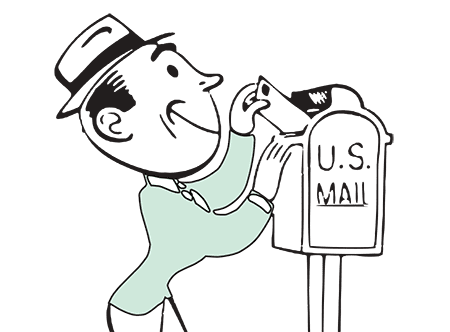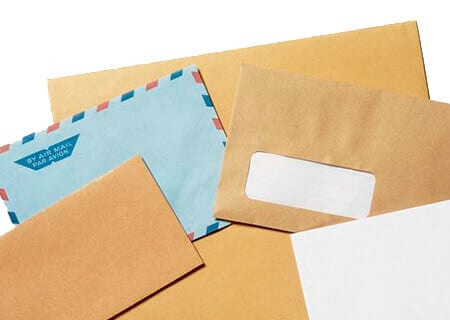Hear ye, hear ye, extra, extra! You’ve got updates, announcements, thank-yous, and stories to share. That’s because things around your business or non-profit are buzzing. Or maybe you’re trying to create some buzz. However it’s going down, a lot of organizations still stick to the traditional way of sharing news: with paper newsletters. Why?
Are Newsletters Old News?
Well, why not stick to the basics of paper? A newsletter is fun to get, fun to read and can cross creatively between sales, entertainment, and prospect nurture. Think of the kooky fare you find in Trader Joe’s Frequent Flyer or the warm fuzzy feeling you get from your favorite non-profit’s well-written annual report.
Newsletter vs. E-newsletter
But with the popularity and success of e-newsletters, you may be wondering: What are some of the advantages of a paper newsletter? And are e-newsletters pushing them out? Let’s look at the pros and cons.
Goals
Whatever your goal, part of the magic of a newsletter is inviting your audience to get to know you a little better, build a relationship, and stay connected. And it doesn’t fit neatly into the category of advertising or campaign.
Among these common factors, you have different goals. They can include:
- Raising awareness
- Sharing a regular calendar and/or list of events
- Telling stories about your organization and/or stories related to its mission
- Nesting specials, discounts, and new features in fun or engaging narrative
- Providing a “members only” inside scoop and showing special appreciation to customers or donors.
Once you’ve identified your goals, decide whether the tangibility and longevity of a paper product or the quick, smart-phone-ready format of digital better serves your purpose.
For example, if you’re advertising regular events, your audience might want to connect that to Google calendars, reminder apps, or Facebook. It needs to be fast, convenient, and accessible—in a word, digital. However, if you want to give an extended preview of the year ahead, paper lets people peruse, plan, and put on their refrigerators. The last thing you want is for big events to get lost in an inbox. Paper is the anti-multi-tasker and makes a good partner to slower, deeper thought and long-term organizing.
Frequency
When are you sending this newsletter out? If weekly, you might not have that much design, print, and mailing in your budget. If quarterly, it may be a smart marketing move to encourage your audience to take time and catch up with you a few times a year. E-news tends to inform quickly and provide blurbs-to-go, from updated statistics to brief, thoughtful reflections. Therefore, they can hit the inbox more frequently and build a sustained connection over time. Paper newsletters invite readers to cozy up for a sustained connection now.
Are you going for quick and frequent, or quality over quantity?
Content
A newsletter with fundraising campaign updates, for example, probably doesn’t need to hit the inbox every week. And important financial news gains credibility when shared on paper. The more content is sensitive, unique, or personal, the more it might be suited for paper.
Or take stories and articles. They invite slowing down, but that can work either on paper or a screen. The key difference is the interaction you want with that content. If it’s all right for your audience to consume a story, article, or blog post, respond with a click and move on with their day, you’re often just as well served with e-news. But if you’re wanting your audience to consider whether to sponsor your cause or to take on complex business or political issues, paper can broaden mental space and encourage thoughtfulness. Digital works best in snippets.
Design
Email news comes with templates, and once you have that down, sending out a new edition can be a snap. But lower rates of postal mail these days can make a paper newsletter really stand out. And newsletter design can come from a strong template, too, don’t forget. Both newsletters and e-news have the ability to be vibrant, appealing, colorful, and enjoyable. But consider whether your design could benefit from the “3-D” aspect of paper, where you can play with choices like texture, ink, pages, shape, tear-out portions (like coupons), folds and fold-outs.
Audience
Who’s your target audience? And do they tend to really get behind paper? Older audiences and Millennials especially appreciate the simplicity and tangibility of direct mail. The former because, well, they never got tired of it, and the latter because it’s cool again. Whether traditional, retro or the new nice, paper has your back for a variety of audiences.
On the other hand, you may be wanting to create a totally sleek or modern vibe with your organization, and you may have a good intuition that paper efforts would be wasted with your audience. You may market to really busy people, or to large networks. Or you may be sharing information that your audience may want to respond to immediately, by posting a comment or (in the case of a church newsletter, for example) sharing a prayer request with clergy. Only you know when your audience needs that hyperlink.
Budget
Sometimes, it is all about the Benjamins. While e-newsletters are relatively easy to produce, you’re going to need a more quality copywriter for a newsletter, and some extra considerations in design. The written word suggests you’ve made an investment, and you’ve got to live up to it to maintain credibility. Then of course (we’re all thinking it), paper and postage are much more costly, and accurate mailing lists take work.
However, costly isn’t necessarily the opposite of cost-effective. After evaluating goals, audience, and other elements of your publication, you should have a pretty good idea about whether a paper newsletter would be a worthy endeavor, or if, for you, it’s just old news.
Need help getting that newsletter ship-shape? We can help you package it in the best customizable envelope in town. Contact us at Letter Jacket and talk to one of our paper-loving experts.



